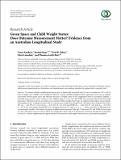Files in this item
Green space and child weight status : does outcome measurement matter? Evidence from an Australian longitudinal study
Item metadata
| dc.contributor.author | Sanders, T. | |
| dc.contributor.author | Feng, Xiaoqi | |
| dc.contributor.author | Fahey, P.P. | |
| dc.contributor.author | Lonsdale, C. | |
| dc.contributor.author | Astell-Burt, Thomas Edward | |
| dc.date.accessioned | 2015-10-27T13:09:59Z | |
| dc.date.available | 2015-10-27T13:09:59Z | |
| dc.date.issued | 2015 | |
| dc.identifier | 226683219 | |
| dc.identifier | cbad9389-d6ad-4843-8974-ff87257f6ef2 | |
| dc.identifier | 84941695734 | |
| dc.identifier | 000214759900005 | |
| dc.identifier.citation | Sanders , T , Feng , X , Fahey , P P , Lonsdale , C & Astell-Burt , T E 2015 , ' Green space and child weight status : does outcome measurement matter? Evidence from an Australian longitudinal study ' , International Journal of Obesity , vol. 2015 , 194838 . https://doi.org/10.1155/2015/194838 | en |
| dc.identifier.issn | 2090-0708 | |
| dc.identifier.uri | https://hdl.handle.net/10023/7699 | |
| dc.description | Taren Sanders is supported by an Australian Postgraduate Award. Thomas Astell-Burt is supported by a Fellowship with the National Heart Foundation of Australia. | en |
| dc.description.abstract | Objective. To examine whether neighbourhood green space is beneficially associated with (i) waist circumference (WC) and (ii) waist-to-height ratio (WtHR) across childhood. Methods. Gender-stratified multilevel linear regressions were used to examine associations between green space and objective measures of weight status in the Longitudinal Study of Australian Children, a nationally representative source of data on 4,423 children aged 6 y to 13 y. WC and WtHR were measured objectively. Percentage green space within the local area of residence was calculated. Effect modification by age was explored, adjusting for socioeconomic confounding. Results. Compared to peers with 0-5% green space locally, boys and girls with >40% green space tended to have lower WC (βboys -1.15, 95% CI -2.44, 0.14; βgirls -0.21, 95% CI -1.47, 1.05) and WtHR (βboys -0.82, 95% CI -1.65, 0.01; βgirls -0.32, 95% CI -1.13, 0.49). Associations among boys were contingent upon age (p valuesage green space40% green space at 73.85 cm and 45.75% compared to those with 0-5% green space at 75.18 cm and 46.62%, respectively. Conclusions. Greener neighbourhoods appear beneficial to alternative child weight status measures, particularly among boys. | |
| dc.format.extent | 8 | |
| dc.format.extent | 1456722 | |
| dc.language.iso | eng | |
| dc.relation.ispartof | International Journal of Obesity | en |
| dc.subject | HV Social pathology. Social and public welfare | en |
| dc.subject | 3rd-DAS | en |
| dc.subject.lcc | HV | en |
| dc.title | Green space and child weight status : does outcome measurement matter? Evidence from an Australian longitudinal study | en |
| dc.type | Journal article | en |
| dc.contributor.institution | University of St Andrews. School of Geography and Geosciences | en |
| dc.identifier.doi | 10.1155/2015/194838 | |
| dc.description.status | Peer reviewed | en |
This item appears in the following Collection(s)
Items in the St Andrews Research Repository are protected by copyright, with all rights reserved, unless otherwise indicated.

